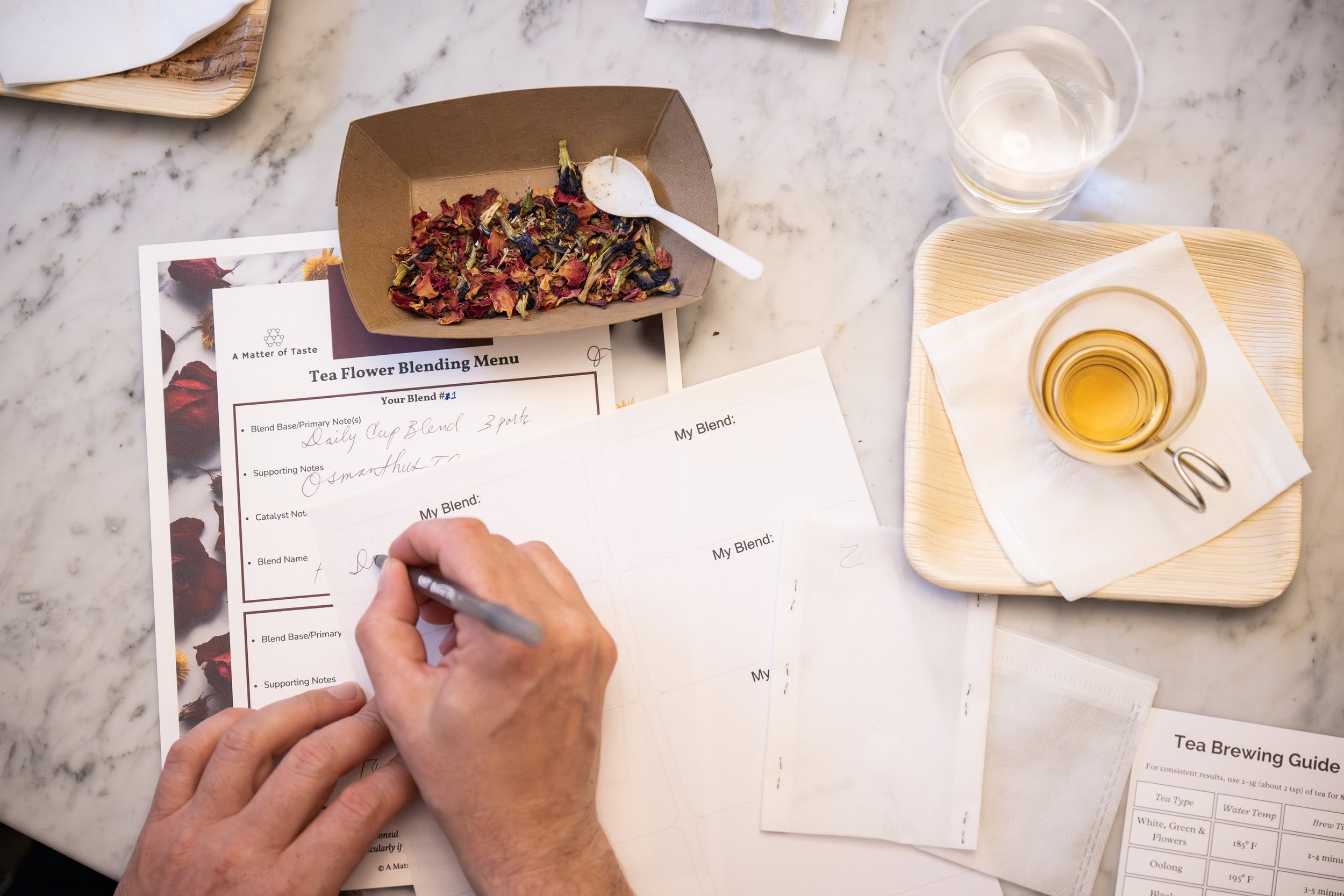Tea for Focus
Shift your perspective with functional herbal teas
Great collaboration starts with presence.
Our flower and tea tasting and blending workshops focus on the Power of Observation, using guided tea tastings as a powerful, hands-on method for building this essential skill.
Our multi-stage tasting journeys explore a curated selection of flowers, herbs and tea blends, exploring all the senses with colors, smells, tastes, textures and even sounds!
The Ladder of Inference, Stages of Observation and other critical thinking tools come together with sensory tasting into an embodied practice to create a space for metacognition, shared perspective, and curiosity.
What Tea Means to Us: a tool for presence
Teas, including the broad category of floral and herbal infusions and tisanes, offer a rich sensory pathway to explore how colors, flavors, and aromas influence our experience. We see tea not merely as a beverage, but as a functional tool for shaping our emotional, mental and collaborative states.
Our Star-Support-Spark Blending Structure
Each of our tea blends follows a thoughtful three-part structure that creates both functional and flavorful experiences:
Star Solution: The central, functional anchor that carries the core emotional or physiological effect
Supporting Cast: Secondary ingredients that amplify, round out, or harmonize with the star
Splash of Flavor: The sensory or visual accent that gives the blend distinction through color, aroma, or a surprising note
Our signature blends, tasted in our workshops and for purchase, are carefully crafted to support the work of human collaboration, named to reflect what they are designed to do and how they move you.
Make It Your Own: Recipes and Resources
-
Butterfly Pea Flowers
Lemongrass
Tulsi (Holy Basil)
Milky Oat Straw
Chrysanthemum Flowers
-
Rose Petals
Butterfly Pea Flower
Rose Hips
Osmanthus
Hibiscus
Tulsi (Holy Basil)
-
Red Rooibos
Honeybush
Chamomile
Hibiscus
Osmanthus
-
Milky Oat Straw
Green Rooibos
Roasted Red Rooibos
Green Honeybush
Roasted Red Honeybush
Incorporate the power of presence into your daily routine with this tea tasting ritual.
You’ll Need:
Small glass teapot (20 oz or so) and tasting cups
2 tablespoons AMOT Tea Blend of your choice
Sugar or honey, to taste
4 ounces hot water (between 175-180°F for Open Voice, ~200°F for other AMOT blends)
4 ounces cool -but not cold- water
Plain crackers (like our Oat Biscuits)
Shop here!
Pour the tea into the pot and add hot water to cover - plus an inch maximum. Aim to fill half the pot.
Gently stir or swirl the teapot for 30 seconds to immerse the flowers and start the color development. As a meditation, think of the people who picked the flowers and protected them on their way to your cup.
Breathe in the aroma of the tea before sampling. Take a small sip and allow it to coat your mouth before swallowing.
Take a bite of cracker, and sweeten tea, if desired. Taste again. As the tea cools, do the flavors intensify?

Ingredients with unique contributions
We work with a curated selection of herbs and botanicals chosen for their unique role in collaboration.
Butterfly Pea Flower: Cooling color and calm energy
Chamomile: Grounding and immune support
Hibiscus: Bright and tart finish
Lemongrass: Fresh, citrusy brightness
Osmanthus: Honey-sweet finish and aroma
Rose Petals & Rosehips: Emotional openness and vitamin C
Tulsi: Clarity and adaptogenic balance
Chrysanthemum: Cooling and clarity-supporting
Oat Straw: Nervous system nourishment
Rooibos & Honeybush: Rich body and naturally sweet flavor
We recommend that you consult with a qualified healthcare practitioner before using any herbal products, particularly if you are pregnant, nursing, or on any medications.




